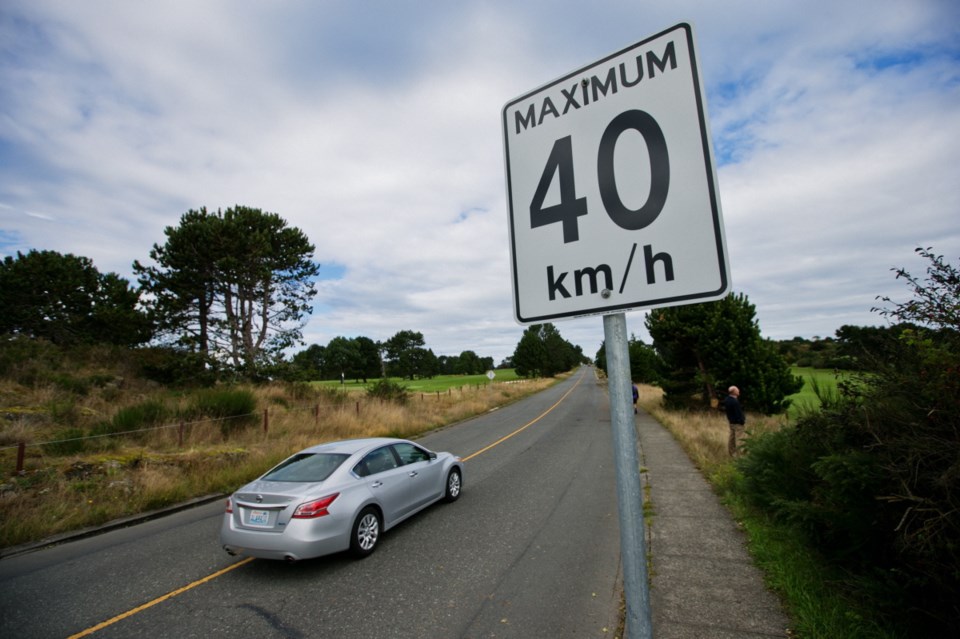City staff are recommending increased enforcement and education as many drivers are ignoring lower speed limits introduced by Victoria two years ago as a traffic safety measure.
In 2014, councillors amended the streets and traffic bylaw reducing the speed limits on several city streets to 40 km/h from 50 km/h and reducing the speed limit on Cook Street between Southgate and Dallas Road to 30 km/h from 50 km/h.
But traffic monitoring conducted in 2015 when compared to 2014 show the reduced speed zones “are having only a minor impact on vehicle speeds” — only a two per cent reduction in speed — with average speeds still above the posted limits, says a staff report.
Since the speed limit reductions, B.C. Transit has complained it has had difficulty keeping to schedule on some routes.
The findings pretty much bear out what city engineering staff predicted, said Coun. Geoff Young.
“They didn’t exactly say: ‘We told you so, you idiots.’ But they sort of said it in their report,” Young said. “It’s pretty much what the staff told us was going to happen which was: not much.”
Coun. Ben Isitt, who championed the lower speed limits with former councillor Shellie Gudgeon, said it was always envisioned that lowering the limits was only a first step.
“How we envisioned this initiative at the time was that it would put a target on these corridors through our neighbourhoods where council wanted to introduce safer speeds. We saw signage as sort of a first step with the real long-term solution being infrastructure improvements and what could be called road diets along those corridors,” Isitt said.
The data shows an average of 53 per cent of all motorists are travelling below the new posted speed limits (79 per cent of motorists in the downtown core and 38 per cent for the non-downtown core are in compliance), says the report.
“For the streets with the new 40 km/h speed, the percentage of vehicles travelling at over 40 km/h dropped from 46 per cent in 2014 to 44 per cent in 2015. For Cook Street, where the speed limit was reduced to 30 km/h, only five per cent of motorists were found to comply with the posted speed limit in 2015 (the 85th percentile speed for Cook Street in 2015 was 48 km/h),” the report says.
While the reduced speeds were hoped to improve safety, early data show the number of collisions have actually gone up.
“Collision statistics remain close to pre-installation levels, showing minor increases in both pedestrian and cycling collisions, which may or may not be related to the changes,” the report says.
Staff say further monitoring is needed to better understand the impacts of the speed limit changes but in the meantime recommend the city:
• Retain, monitor and increase enforcement of the 40 km/h and 30 km/h speed zones.
• Install speed-reader boards in strategic locations along reduced speed zones and implement a public awareness campaign.
• Provide an annual report to council on collision statistics before December 2016.
• Continue to work with B.C. Transit to maximize transit performance in reduced speed zones.
• Continue to introduce speed control elements in new street designs.
• Update council annually on the reduced speed zone performance.
Data collected by police show a slight increase in collisions for pedestrians and cyclists along the 40 km/h streets and no change for Cook Street.
Staff report there were 22 pedestrian collisions along 40 km/h streets in 2015 compared to 19 the previous year. Most of the collisions occurred at intersections as opposed to mid-block.
Young said changing people’s behaviour with regard to the new limits will be a long process.
“I’m of the view that we should be using speed cameras to monitor speeds and enforce them but we also have to be reasonable in the speed demands we make,” Young said.



